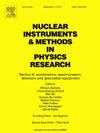低剂量率下摄像机视频中核辐射事件的实时识别算法研究
IF 1.5
3区 物理与天体物理
Q3 INSTRUMENTS & INSTRUMENTATION
Nuclear Instruments & Methods in Physics Research Section A-accelerators Spectrometers Detectors and Associated Equipment
Pub Date : 2025-04-02
DOI:10.1016/j.nima.2025.170485
引用次数: 0
摘要
随着社会生产的进步,核科学技术已广泛应用于工业、农业、医疗、材料科学、考古等各个领域。然而,核技术的应用也涉及一定的风险。当核辐射超过特定剂量阈值时,就可能对人体健康有害,对公共安全甚至国家安全构成威胁。确保核安全与核辐射的探测和监测密切相关。互补金属氧化物半导体(CMOS)传感器广泛可用且具有成本效益。在低剂量率环境下,基于cmos的核辐射探测是加强核安全的一种创新方法。核辐射产生的高能射线直接与CMOS相互作用,沉积的能量转化为大量的电荷,在图像中表现为超过背景的亮点。本文利用Yolov5卷积神经网络模型,提出了一种低剂量率下辐射亮点的实时检测算法。首先,我们使用帧差法和计数器(CNT)算法进行背景减法等技术对核辐射亮点进行初步提取。随后,利用增强的Yolov5模型对初步检测结果进行进一步细化。最后,根据核辐射事件的特点设计了实验,在实际应用中验证了算法的准确性,实现了对核辐射事件的高效实时识别。本文章由计算机程序翻译,如有差异,请以英文原文为准。
Research on real-time identification algorithm of nuclear radiation events in Camera videos under low dose rates
With the advancement of social production, nuclear science and technology have been widely applied across various fields, including industry, agriculture, medical care, materials science, and archaeology. However, the application of nuclear technology also involves certain risks. When nuclear radiation exceeds a specific dose threshold, it can be harmful to human health, posing threats to public safety and even national security. Ensuring nuclear safety is closely linked to the detection and monitoring of nuclear radiation. Complementary Metal Oxide Semiconductor (CMOS) sensors are widely available and cost-effective. In environments with low dose rates, CMOS-based nuclear radiation detection represents an innovative approach to enhancing nuclear safety. High-energy rays produced by nuclear radiation interact directly with CMOS, depositing energy that converts into a substantial amount of charge, which manifests as bright spots that exceed the background in images. This paper proposes a real-time detection algorithm for identifying radiation bright spots under low dose rates, utilizing the Yolov5 convolutional neural network model. Initially, we perform a preliminary extraction of nuclear radiation bright spots using the frame difference method and the counter (CNT) algorithm for background subtraction, among other techniques. Subsequently, the enhanced Yolov5 model is employed to refine the preliminary detection results further. Finally, experiments are designed based on the characteristics of nuclear radiation events to validate the accuracy of the proposed algorithm in practical applications, enabling efficient real-time identification of nuclear radiation events.
求助全文
通过发布文献求助,成功后即可免费获取论文全文。
去求助
来源期刊
CiteScore
3.20
自引率
21.40%
发文量
787
审稿时长
1 months
期刊介绍:
Section A of Nuclear Instruments and Methods in Physics Research publishes papers on design, manufacturing and performance of scientific instruments with an emphasis on large scale facilities. This includes the development of particle accelerators, ion sources, beam transport systems and target arrangements as well as the use of secondary phenomena such as synchrotron radiation and free electron lasers. It also includes all types of instrumentation for the detection and spectrometry of radiations from high energy processes and nuclear decays, as well as instrumentation for experiments at nuclear reactors. Specialized electronics for nuclear and other types of spectrometry as well as computerization of measurements and control systems in this area also find their place in the A section.
Theoretical as well as experimental papers are accepted.

 求助内容:
求助内容: 应助结果提醒方式:
应助结果提醒方式:


